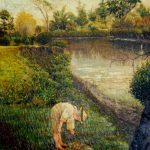
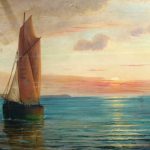
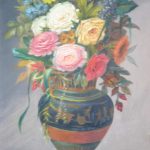
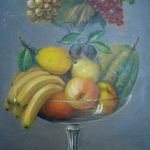
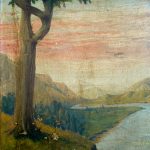


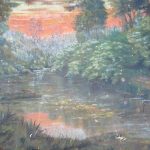
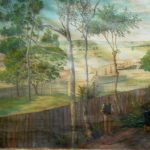
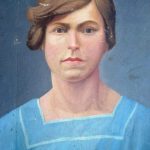
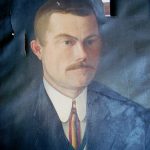

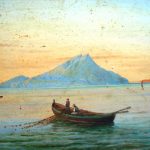
Hans Rasmussen Buch was a local Brisbane artist. Unfortunately little is known about his oil paintings that have survived. The paintings are in the possession of three of Han’s Rasmussen’s descendents.
Half a dozen paintings are in the collection of a grandson (Roy Buch) and great grand-daughter (Carol Rice), the son & grand-daughter of Hans Rasmussen’s son, Robert.
The thirteen paintings listed below were originally in the collection of a great grandson (Neville Buch), the eldest grandson of Hans Rasmussen’s son, Hans. In August 2011 three of the paintings were donated to the State Library of Queensland. These are three paintings which are particularly important in that they depict scenes of East Brisbane around the turn of the twentieth century.
Many of the paintings are slightly damaged and three paintings are significantly damaged. There is a tear in the portrait of Hans Buch Jr. Many of paintings have their original ornate frames. The large painting of the backyard view at East Brisbane has no frame at all. Quite of a few of the frames need repairs.
There is no evidence that Hans painted the two Norwegian paintings, the ‘Danish Waters’ and ‘Ischia’ paintings, in Europe and brought them to Queensland in 1887. Roy Buch remembers that Hans Rasmussen painted scenes from geographical magazines.
Roy Buch indicates that the board used in many of the paintings are referred to as “Beaver Board”.
Hans Rasmussen Buch
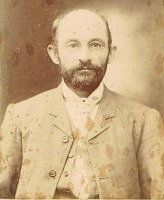
On 15 September 1878 Hans married Augusta Louise Andersen at St Paul’s Church, Copenhagen. The couple lived in few different homes in Copenhagen before residing in Norregarde around 1884-1885. The Queensland colonial government was recruiting for Scandinavian migrants, sending agents to the three Scandinavian countries, and advertising in these countries with handbills and poster billboards. The Queensland government offered an assisted passage program for would-be immigrants. It would have been a momentous decision for Hans & Augusta. Thousands of Northern & Southern Europeans were migrating to the Americas and Australasia in the late nineteenth century but it meant a total extraction from the familiar environment of extended family & culture, and ending up in primitive townships set against an alien landscape. To take such an adventure, you probably felt that the prospects were not particularly good in the home country and that the other-side of the world promised some second chance for a better life.
By this time Hans & Augusta had four children. A daughter, Veronica, died in infancy. With three boys, Robert (age 5), Hans Jr (age 2), and Albert (Age 1), they made their way to London in 1886. At Blackwall Pier on the London Docks, the family departed aboard the ship “Almora”, on 11 January 1887. The Buch family arrived in Rockhampton later in the year. The family travelled as “Free Nominated”, as opposed to Assisted, Free or Remittance Passage. Hans was listed as a painter and Hans & Augusta were in their early thirties.
The journey would have been arduous. Whether from the travel or succumbing to the new conditions of tropical Queensland, young Robert died in Rockhampton in a matter of weeks from the time of their arrival. A few months after Robert’s death, Emily was born. Carl was born three years later, meaning that Hans & Augusta again had four children, all under the age of six, this time living in George Street, Rockhampton.
Sometime between 1890 and 1892 the Buch family moved down the Queensland coast to Brisbane. They lived, in short succession, in Paris Street, West End, and both Ashfield Street and Heidelberg Street, East Brisbane. From at least 1896 and for the next two decades, they resided in Heidelberg Street. The three younger children were added to the family – Elsa, Augusta, and (another) Robert. Albert, born two years before the family left Denmark, only made it to his 19th birthday; he died in 1904. With Albert’s demise, the middle-aged Hans & Augusta shared the house with the adult & eldest son Hans and five other children.
Figure 1: Buch Children circa 1898. From L-R, Elsa, Carl (Top), Robert, Hans, Augusta, Albert, Emily.
Hans Rasmussen Buch was active during these years in the local Danish Association, known as “Heimdal”. The association was established in 1872, in Brisbane; originally as a broad Scandinavian society, the first in Australia. From 1929 it became an exclusively Danish friendly society. Hans served as President of the Danish Association “Heimdal” for 1894-1895 and for 1899-1900.
Han’s wife, Augusta Louise, died in 1915. In his widower years Hans lived with his eldest son and his family. He lived for most of those years in Slacks Creek and died on 10th July 1935.
Was this article interesting to you?
Have something to share about this article?
Neville Buch
Latest posts by Neville Buch (see all)
- Dear grossly, ethically, corrupted - December 21, 2024
- Thoughts with a Professional History colleague on “Artificial Intelligence” - December 21, 2024
- Stephanie M. Lee on “AI by omission”, The Chronicle of Higher Education, Thursday, December 19, 2024 - December 20, 2024

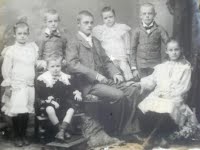
 Press the Heart to Like!
Press the Heart to Like!